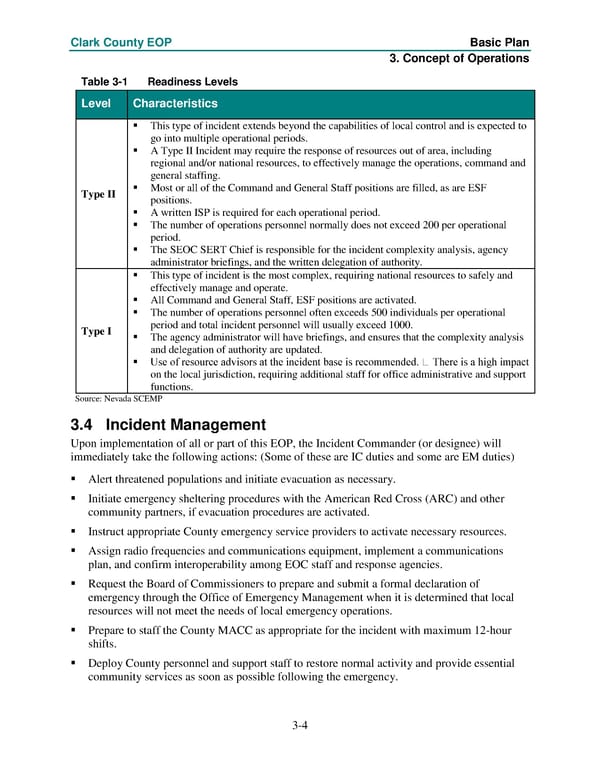Clark County EOP Basic Plan 3. Concept of Operations Table 3-1 Readiness Levels Level Characteristics This type of incident extends beyond the capabilities of local control and is expected to go into multiple operational periods. A Type II Incident may require the response of resources out of area, including regional and/or national resources, to effectively manage the operations, command and general staffing. Type II Most or all of the Command and General Staff positions are filled, as are ESF positions. A written ISP is required for each operational period. The number of operations personnel normally does not exceed 200 per operational period. The SEOC SERT Chief is responsible for the incident complexity analysis, agency administrator briefings, and the written delegation of authority. This type of incident is the most complex, requiring national resources to safely and effectively manage and operate. All Command and General Staff, ESF positions are activated. The number of operations personnel often exceeds 500 individuals per operational Type I period and total incident personnel will usually exceed 1000. The agency administrator will have briefings, and ensures that the complexity analysis and delegation of authority are updated. on the local jurisdiction, requiring additional staff for office administrative and support functions. Source: Nevada SCEMP 3.4 Incident Management Upon implementation of all or part of this EOP, the Incident Commander (or designee) will immediately take the following actions: (Some of these are IC duties and some are EM duties) Alert threatened populations and initiate evacuation as necessary. Initiate emergency sheltering procedures with the American Red Cross (ARC) and other community partners, if evacuation procedures are activated. Instruct appropriate County emergency service providers to activate necessary resources. Assign radio frequencies and communications equipment, implement a communications plan, and confirm interoperability among EOC staff and response agencies. Request the Board of Commissioners to prepare and submit a formal declaration of emergency through the Office of Emergency Management when it is determined that local resources will not meet the needs of local emergency operations. Prepare to staff the County MACC as appropriate for the incident with maximum 12-hour shifts. Deploy County personnel and support staff to restore normal activity and provide essential community services as soon as possible following the emergency. 3-4
 Emergency Operations Plan Page 46 Page 48
Emergency Operations Plan Page 46 Page 48